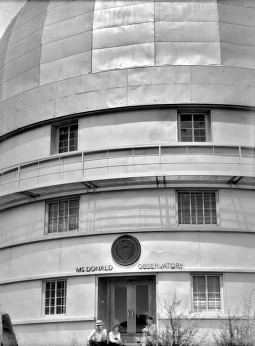Altitude 2,070 m (6,790 ft) Phone +1 432-426-3640 Code 711 | Opened 1933 Established 1933 | |
 | ||
Location Jeff Davis County, United States of America Website mcdonaldobservatory.org Hours Open today · 10AM–5:30PMThursday10AM–5:30PMFriday10AM–5:30PMSaturday10AM–5:30PMSunday10AM–5:30PMMonday10AM–5:30PMTuesday10AM–5:30PMWednesday10AM–5:30PM Similar Fort Davis National Historic S, Hobby–Eberly Telescope, El Paisano Hotel, Big Bend National Park, Chinati Foundation Profiles | ||
The texas bucket list mcdonald observatory
The McDonald Observatory is an astronomical observatory located near the unincorporated community of Fort Davis in Jeff Davis County, Texas, United States. The facility is located on Mount Locke in the Davis Mountains of West Texas, with additional facilities on Mount Fowlkes, approximately 1.3 kilometers (0.81 mi) to the northeast. The observatory is part of the University of Texas at Austin. It is an organized research unit of the College of Natural Sciences.
Contents
- The texas bucket list mcdonald observatory
- Introducing mcdonald observatory
- History
- Observatory
- Telescopes
- Tenant telescopes
- Former telescopes
- Climate
- Visiting
- References
The observatory produces StarDate, a daily syndicated radio program consisting of short segments related to astronomy that airs on both National Public Radio and commercial radio stations — about 400 affiliates in all.
Introducing mcdonald observatory
History
The McDonald Observatory was originally endowed by the Texas banker William Johnson McDonald (1844–1926), who left about $1,000,000 - the bulk of his fortune - to the University of Texas to endow an astronomical observatory. The provision of the will was challenged by McDonald's relatives, but after a long legal fight, the University received about $800,000 from the estate and construction began at Mt. Locke. The then-unnamed Otto Struve Telescope was dedicated on May 5, 1939, and at that time was the second largest telescope in the world. McDonald Observatory was operated under contract by the University of Chicago until the 1960s, when control was transferred to the University of Texas at Austin under the direction of Harlan J. Smith.
Research today at the McDonald Observatory encompasses a wide variety of topics and projects, including planetary systems, stars and stellar spectroscopy, the interstellar medium, extragalactic astronomy, and theoretical astronomy.
Directors
Observatory
The McDonald Observatory is equipped with a wide range of instrumentation for imaging and spectroscopy in the optical and infrared spectra, and operates the first lunar laser ranging station. It works closely with the astronomy department of the University of Texas at Austin while maintaining administrative autonomy. The high and dry peaks of the Davis Mountains make for some of the darkest and clearest night skies in the region and provide excellent conditions for astronomical research.
The Otto Struve Telescope, dedicated in 1939, was the first large telescope built at the observatory. It is located on Mt. Locke at an altitude of 2,070 m (6,790 ft). The summit of Mt. Locke, accessed by Spur 78, is the highest point on Texas highways. The Harlan J. Smith Telescope, also on Mt. Locke, was completed in 1968.
The Hobby-Eberly Telescope (HET), dedicated in late 1997, is located on the summit of Mt. Fowlkes at 2,030 m (6,660 ft) above sea level. It is operated jointly by the University of Texas at Austin, Pennsylvania State University, Ludwig Maximilians University of Munich, and Georg-August University of Göttingen. As of 2012, the HET is tied with the similar Southern African Large Telescope (SALT) as the fifth largest telescope in the world. However, its cost was about 20% that of other similarly-sized telescopes in use today due to its optimization for spectrography.
Telescopes
Currently, the observatory operates four research telescopes at its West Texas site:
A 0.9 m (36 in) telescope, formerly used for research, is now used for visitor programs.
Tenant telescopes
The two peaks also host a number of other instruments:
Former telescopes
Climate
The observatory experiences a semi-arid climate (Köppen BSk) with cool, dry winters and hot, dry summers.
Visiting
The Frank N. Bash Visitors Center, located between Mt. Locke and Mt. Fowlkes, includes a café, gift shop, and interactive exhibit hall. The Visitors Center conducts daily live solar viewings in a large theater and tours of the observatory's largest telescopes. It also hosts evening star parties, every Tuesday, Friday, and Saturday evening which allow visitors to look through numerous telescopes of various sizes in the Telescope Park, including the wheelchair accessible Wren Marcario Accessible Telescope (a Pfund Telescope), and enjoy an indoor program.
Special viewing nights, during which visitors can stay on-site (not required for the programs) and view directly through eyepieces on the 0.9 m, Struve (2.1m), or Smith (2.7m) telescopes, are held on a reservation-only basis. Although not available for several years, as of June 2013, the 2.1m has returned to occasional public access.
